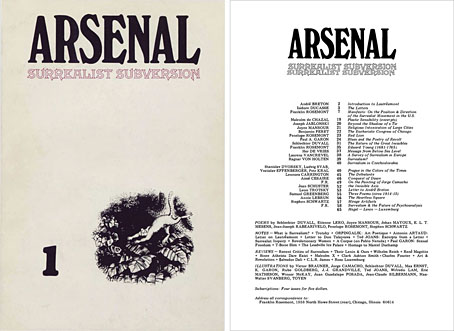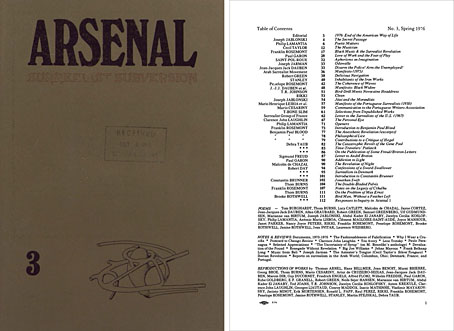It’s the “S” word again. I said at the beginning of this month that I was looking forward to seeing where this interest led, and here we are. My recent reading has included Penelope Rosemont’s Surrealist Women (1998), a comprehensive study that I’d dipped into in the past but hadn’t gone through properly until now. In the section devoted to activities since the 1960s Rosemont mentions a magazine, Arsenal: Surrealist Subversion, which she produced with her husband, Franklin Rosemont, as part of their work with the Chicago Surrealist Group. Arsenal had more of an erratic schedule than most magazines, managing four issues that appeared in 1970, 1973, 1976 and 1989. I really didn’t expect there to be copies of such an obscure publication available anywhere but, once again, the invaluable Internet Archive has scans of the first three issues.
Arsenal proves to be a curious mix of the kind of material you’d expect from a Surrealist publication—poetry, essays, drawings, collages, significant quotes—together with chunks of Marxist politics and Freudian business that seem to have strayed in from another magazine. The latter material isn’t so unwarranted, being a reflection of André Breton’s original concerns, but committed Marxists of whatever stripe have never had much time for Surrealist art-creation and game-playing, while Freud himself was nonplussed by Breton’s attempts to interest him in the activities of the Parisian Surrealists. Breton casts a long shadow here; the Rosemonts had met him in Paris in the mid-60s, and many of the articles (also their combative attitudes) have a Bretonian cast.
Elsewhere, Arsenal breaks new ground with a Surrealist appraisal of blues musicians, music being a form that Breton and Louis Aragon had dismissed in the 1920s as “too confusing” for incorporation into the Surrealist project. The magazine also reprints a couple of comic strips, including a page of Little Nemo in Slumberland which may be the first acknowledgement from inside Surrealism of Winsor McCay’s dream-worlds as Surrealist precursors. And after posting Breton’s musings about “The Great Transparent Ones” these mysterious beings surface once again. Not only the Great Transparent Ones but also HP Lovecraft’s Great Old Ones in a piece by Franklin Rosemont about the Cthulhu Mythos. Rosemont draws attention to the obvious similarity between the names of Breton and Lovecraft’s beings, while also noting Lovecraft’s prowess as a transcriber of dreams. In doing so he complains about Lovecraft circumscribing his imagination by resorting to the story structures of the pulp magazines. Lovecraft was never a member of any avant-garde literary circle, however, unlike Clark Ashton Smith, who also receives further mention in these pages; if it wasn’t for Weird Tales we never would have heard of HP Lovecraft and there wouldn’t be a Cthulhu Mythos. This fault-picking is typical of many other pieces in the magazine, the book reviews in particular where a kind of petulant bad temper is the predominant tone. You probably can’t expect much else from a magazine that names itself after a store of weapons but the cumulative effect makes it seem that the road to the Marvellous must be paved with razor blades and broken glass. To their credit, the editors did print in the third issue some of the negative reviews they received for the previous two, including the inevitable dismissals from hardline Communists. Despite all this I’d still like to see how things developed (or came to an end) in the fourth and final issue.
• Further reading: I Could Dream In French: An Interview With Penelope Rosemont.
Elsewhere on { feuilleton }
• The Surrealism archive
Previously on { feuilleton }
• First Papers of Surrealism
• The original Cabaret Voltaire
• View: The Modern Magazine




Interesting link. I skimmed through these just now, and what a time capsule they are. Nascent identity politics sharing space with old-fashioned Marxism. I’ve always considered Surrealism and Marxism to be an uncomfortable and forced marriage, and these magazines would be my new Exhibit A.
On the other hand, there are some great quotes sprinkled in there; an interesting article on witchcraft from the closing days in which Margaret Murray could still be cited as an authority, and other intriguing tidbits.
And as you pointed out, those are some ill-tempered book reviews! A couple of them made me chuckle.
The Surrealist adherence to Marxism or any of its off-shoots is continually surprising. It’s understandable if people are following Breton’s lead but the traffic only ever seems to be one way. Marxists are atheist materialists whose main concerns are hard material problems, not the world of dreams, the occult or weird fiction. I suspect that Surrealists in Marxist circles are often tolerated as useful idiots (to borrow a phrase of Lenin’s…), good to have around on picket lines or demonstrations but with little to add otherwise. Louis Aragon was famously forced to renounce Surrealism on his first visit to the Soviet Union, something which got him expelled from Breton’s group when he returned to Paris. All political ideologies distrust the unfettered imagination because that’s where alternatives to ideologies are born.
Arsenal is still an interesting magazine all the same.
Interesting reading, undeniably, but I do find something off-puttingly cult-like in some of the thinking on display.
It’s the Cult of Breton. The editorial position parrots his line, so Dalí is dismissed with Breton’s anagram, “Avida Dollars”, while Max Ernst, in the year of his death, is also dismissed with the suggestion that he should have killed himself in 1955, the year when Breton and co. expelled him from their version of Surrealism. Ernst’s “crime” was to accept an award for painting… I respect Breton for many things but he could be a real dick in person, while also running the Parisian Surrealists like a petty authoritarian. Breton’s “my way or the highway” attitude is particularly ridiculous when the movement and philosophy was supposed to be oriented towards imaginative liberation and freedom.
I actually own a print copy of the 1989 issue, found at a library book sale for $2 or $3. I enjoy it more in concept than reality, but it was definitely a fun thing to discover among the (mostly) generic other books at the sale.
Anyway, I’ve been reading your posts here for a few years and there’s always plenty of brain-fodder to be found here. Thanks for continuing to do it.
This issue of Cultural Correspondence, edited by Franklin Rosemont, is something of a goldmine… https://monoskop.org/images/9/95/Cultural_Correspondence_10-11_Surrealism_and_Its_Popular_Accomplices_1979.pdf
A great find, thanks! I’ve grabbed a few things from Monoskop but that’s one I missed.
City Lights republished that issue of Cultural Correspondence in an identical format as a paperback with a red cover.